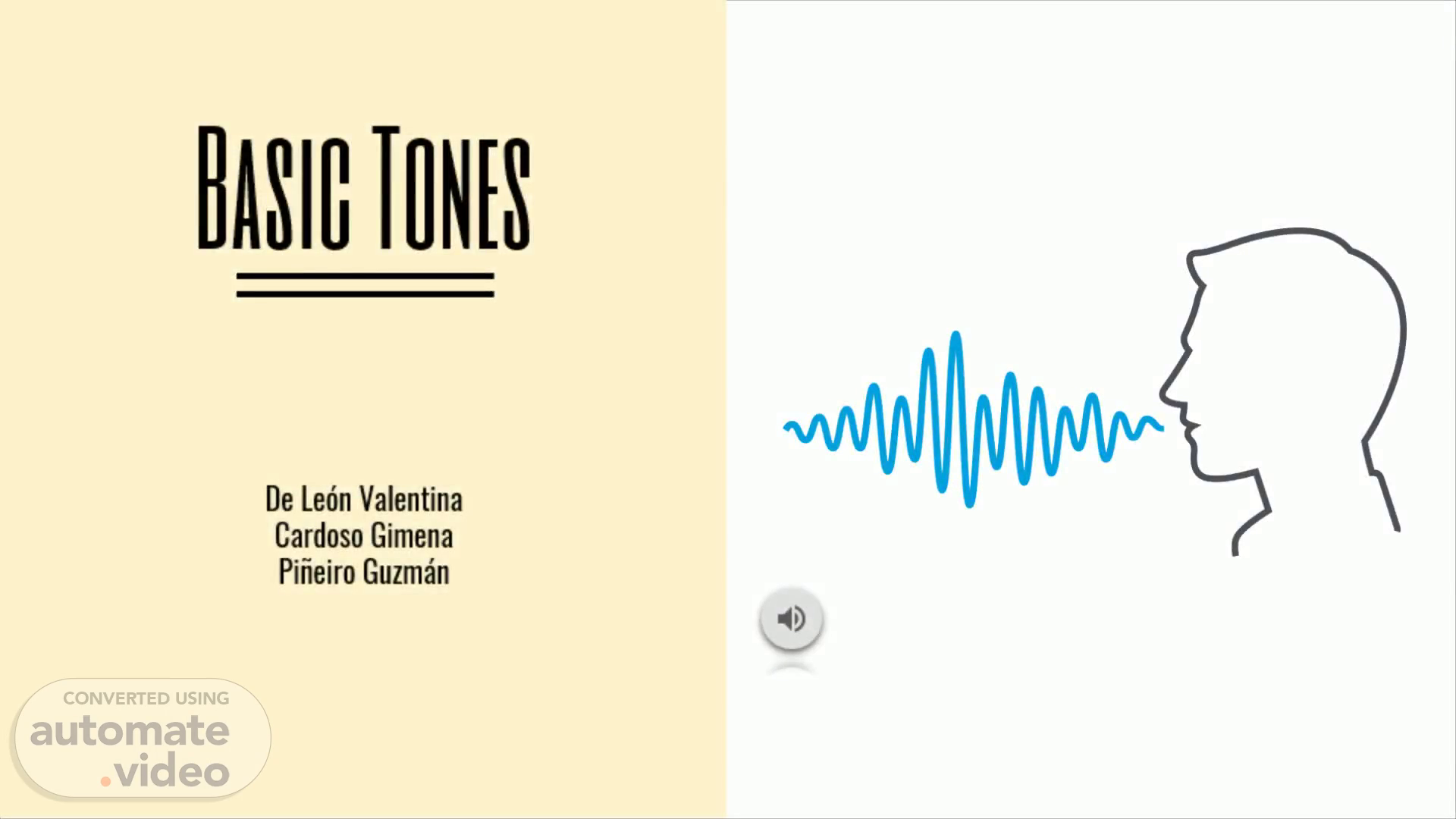
PowerPoint Presentation
Scene 1 (0s)
Basic Tones. De León Valentina Cardoso Gime na Piñeiro Guzmán.
Scene 2 (8s)
objectives. To provide definitions of intonation. To explain each function of Intonation and associate them with their corresponding tone(s). To provide examples of each tone use..
Scene 3 (19s)
Introduction. “A combination of acoustic parameters, including duration, intensity and pitch used to communicate discourse meaning.” Levis (2013). “The use of pitch in discourse; it is usually distinguished from the use of pitch to differentiate words as in so called “tone languages.” Tench (). “In studying intonation we study how the pitch of the voice rises and falls, and how speakers use this pitch variation to convey linguistic and pragmatic meaning.” Wells (2009). “Only in a very unusual situation do we speak with fixed, unvarying pitch, and when we speak normally the pitch of our voice is constantly changing.” Roach (2009)..
Scene 4 (51s)
Functions. Communicative Function Attitudinal Function Accentual Function.
Scene 5 (1m 0s)
Communicative Function. Quiz In order to express assertiveness, the speaker would use a Falling tone. Eg: What country has the largest population in the world? Chi na Also, the Fall indicates “full” sentences and may accompany an interrogative clause when one of the interlocutors needs to repeat the question. WH questions are usually said with a fall tone which indicates that the speaker knows that at least any part of what has been asked is true. “What happened?” (The speaker knows that something happened) According to Mott, a Falling Tone indicates: Semantic function: signal of definiteness and completeness Grammatical association: declarative utterances/stat ements If the speaker does not feel sure about the answer, he or she might adopt a Rising tone. Eg: What country has the largest population in the world? Chi na.
Scene 6 (1m 35s)
Falling tones vs Rising Tones Fall speaker's knowledge, whereas the Rise indicates the speaker´s lack of knowledge. The Rise is also part of the (spoken) Yes/No questions and declarative clauses. WH questions can also be said with Rise tone, especially in echo questions. Eg:Which country did you say? Questions Tags: tones also indicate the speaker´s notion of the topic. Eg:while Falling tags indicate confirmation from the other interlocutor, Rising tags mean that the speaker is not so sure about what has been said. • it’s \China | \isnt it (fall on tag) • it’s \China | /isnt it (rise on tag) POWER Eg: commands dominance. Falling tone. However, if the speaker does not feel powerful enough is prompted to use a Rise tone in order to indicate a request. Consider the following differences between: • I want you back by \ten (= command) • can you be back by /ten (= request) and then between • be back by \ten (= command) • be back by /ten (= request).
Scene 7 (2m 17s)
The Rise indicates the speaker´s respect and esteem. • dont argue with your \mother (= prohibition) • dont argue with your /mother (= plea) • come \on (= demand) • come /on (= coaxing) • you should check your \watch (= advice) • you could check your /watch (= suggestion) • I will be back by \ten (= promise) • I will be back by /ten (= offer) • \watch it (= threat) • /watch it (= warning) Social interaction. Consider the following utterances. • good \morning • good /morning.
Scene 8 (2m 38s)
in conclusion. Falling Intonation: Ordinary statements WH questions Exclamations Imperatives (Commands) Questions Tags (Speaker not expecting an answer; he is sure, certain) Alternative questions Listing, enumerating. Rising Intonation: Yes/No questions Questions Tags (Speaker less certain of his remarks) Imperatives (To soften the command; to sound less abrupt) WH questions (Expressing surprise or asking for repetition).
Scene 9 (2m 56s)
Attitudinal Function. The intonation realized can indicate the attitude of the speaker towards the information being transmitted..
Scene 10 (3m 6s)
High-fall Strength of feeling. Low-fall Mildness.
Scene 11 (3m 26s)
Attitudinal Function. Rising tones. High pitched rise Not certain.
Scene 12 (3m 38s)
Attitudinal Function. Rising vs Falling: Authority & Social Interaction.
Scene 13 (4m 5s)
Attitudinal Function. High Fall. Stronger expression of attitude.
Scene 14 (4m 12s)
Informational Function.
Scene 17 (4m 29s)
Textual Function.
Scene 19 (4m 41s)
Accentual Function.
Scene 21 (4m 52s)
Grammatical Function. -G rammar and syntactic structure recognized by what is being said using the information of the intonation -.
Scene 23 (5m 7s)
Genre-specific Function. Every culture has different kinds, or genres, of spoken discourse by the very sound of them. Recognition of genre-recognition sounds combination of: - length of intonation units - falls and rises -degree of variety in tones -amount of variation in speed - loudness - pitch and rhythm - presence or absence of vocal qualities.
Scene 25 (5m 30s)
conclusion. Intonations used to convey feelings and attitudes. Foreign Learners Practice.